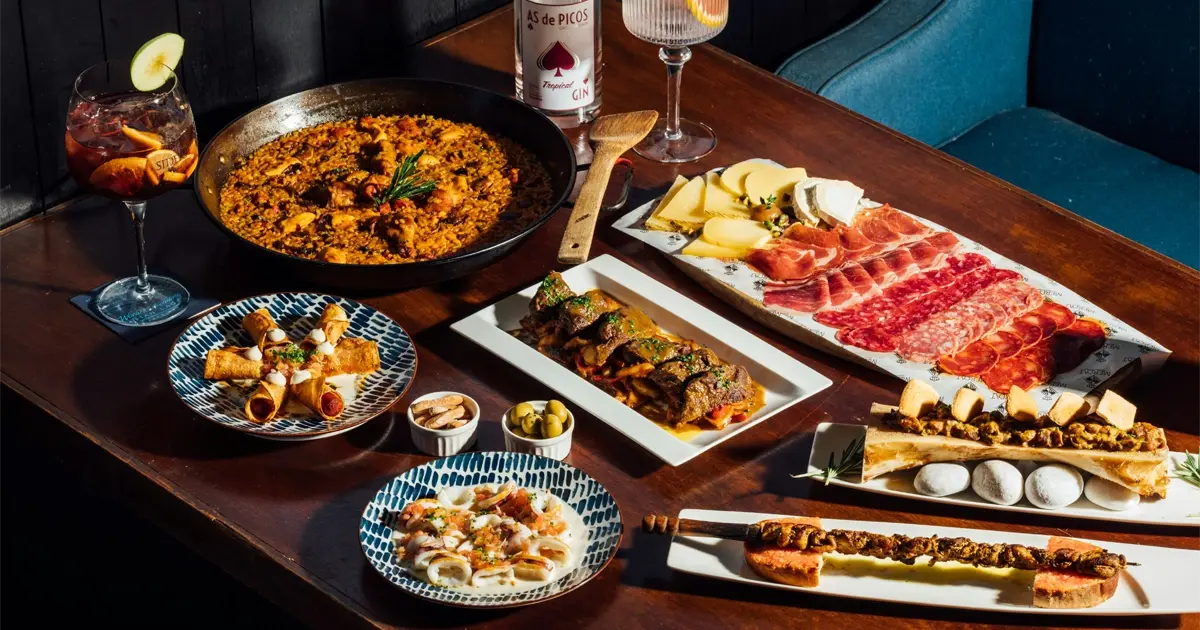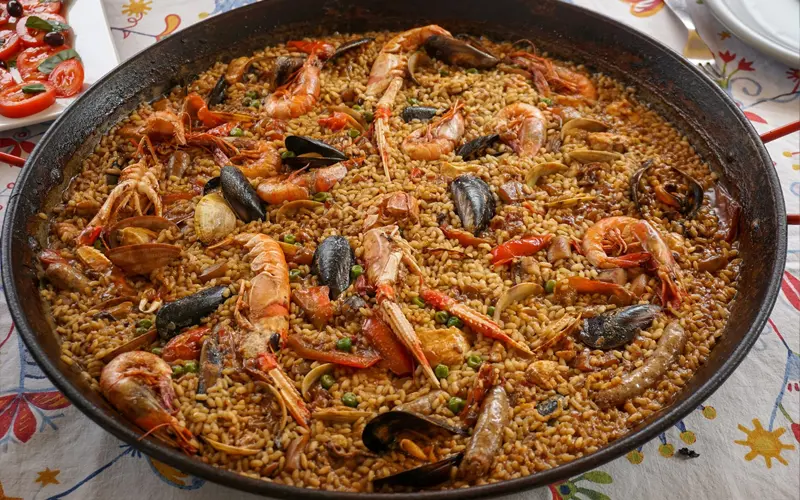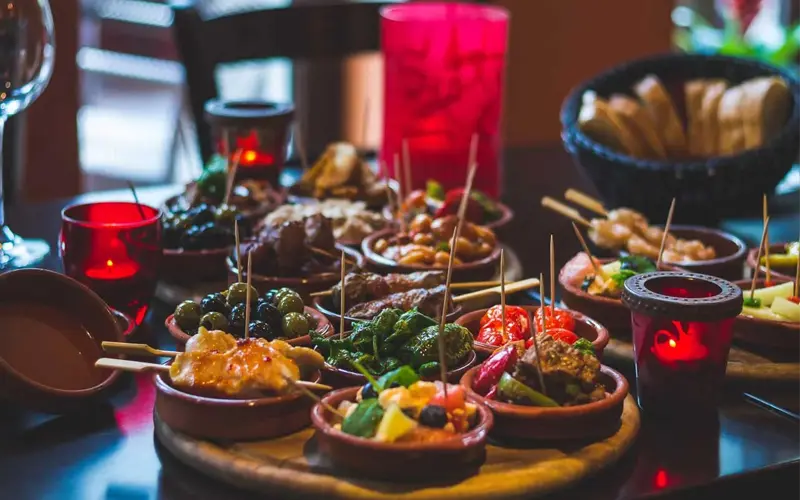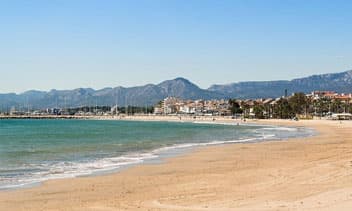
Mediterranean Diet in Spain: Health, Flavors and a Way of Life
Last update: September 3, 2025
Reading time: 19.1 min
No Time to Read It All? Here’s the Quick Summary:
The Mediterranean diet in Spain is built around olive oil, vegetables, fruits, legumes, fish, and whole grains. Its scientifically proven benefits include cardiovascular protection, diabetes prevention, increased longevity, and healthy aging. It comes to life through iconic dishes such as gazpacho, paella, tortilla, or pan con tomate, and reflects a lifestyle rooted in conviviality, local markets, regular physical activity, and a relaxed pace of life. Each region—Andalusia, Catalonia, Valencia, and the Balearic Islands—offers its own interpretation, making Spain a global model of quality of life, especially valued by retirees and expatriates.
The Mediterranean Diet, Between Tradition and Modernity
Definition and Origins of the Mediterranean Diet
The Mediterranean diet—also known as the Mediterranean way of eating or the Cretan diet—is far more than a simple nutritional model: it is a cultural heritage shaped over millennia along the shores of the Mediterranean basin and still alive today. Centered on fresh, local, and minimally processed foods (olive oil, vegetables, fruits, fish, whole grains…), this diet emphasizes simplicity, variety, and balance. Passed down from generation to generation, it has adapted to modern lifestyles without ever losing its relevance.
UNESCO Recognition and International Rankings
Since 2010, this culinary heritage has been recognized by UNESCO as part of the Intangible Cultural Heritage of Humanity, underlining its importance to Mediterranean identity. More recently, international rankings such as U.S. News & World Report have named it the “world’s best diet” across all categories. These honors confirm what scientific research consistently demonstrates: this traditional way of eating helps prevent numerous diseases and supports exceptional longevity.
Spain’s Role and Article Overview
Spain, considered one of the cradles of the Mediterranean lifestyle, exemplifies its benefits better than any other country. From Andalusian olive groves to Valencia’s markets and Catalan specialties, each region offers its own version of this dietary model, blending health and pleasure. In this article, we’ll explore its proven health benefits, the staple foods of Spanish gastronomy, its most iconic dishes, and the way it is deeply integrated into local lifestyle—a major advantage for anyone choosing to settle in Spain.
Proven Health Benefits of the Mediterranean Diet
Cardiovascular Health and Disease Prevention
One of the Mediterranean diet’s greatest strengths lies in its ability to protect the heart and arteries. Rich in unsaturated fats from olive oil, fiber from vegetables, and omega-3 fatty acids from fish, this dietary model helps lower LDL cholesterol (“bad cholesterol”) and regulate blood pressure. A large Spanish study (PREDIMED) showed that a Mediterranean diet enriched with extra virgin olive oil or nuts reduced the risk of major cardiovascular events by nearly 30% compared to a low-fat diet. These results confirm its role as a true protective shield against heart attacks, strokes, and other cardiovascular conditions.
Longevity and Prevention of Chronic Diseases
The Mediterranean diet is also closely linked to longer life expectancy and a reduced risk of age-related diseases. By limiting abdominal obesity, providing a wide range of antioxidants, and ensuring a high intake of dietary fiber, it lowers the risk of type 2 diabetes, certain cancers, and chronic respiratory diseases. Cohort studies have shown that people who adhere closely to this diet reduce their risk of premature mortality by about 20%. Thanks to its balance of lean proteins, complex carbohydrates, and healthy fats, it offers long-term protection against many chronic conditions.
Cognitive Protection and Healthy Aging
Beyond physical health, the Mediterranean diet also has a positive impact on the brain. Its richness in omega-3 fatty acids, polyphenols, vitamins, and minerals helps protect neurons and slow cognitive decline. Long-term studies have highlighted a significant reduction in the risk of neurodegenerative diseases such as Alzheimer’s and Parkinson’s among those following this way of eating. By prioritizing quality fats and reducing refined sugars, the diet supports stronger memory, sharper concentration, and healthier brain aging.
Other Benefits (Weight, Gut Health, Fertility, Vitality)
The Mediterranean diet also provides a wide range of additional health benefits. Thanks to its high fiber content and nutrient density, it promotes satiety and helps maintain a stable weight without restrictive dieting. Its plant diversity enriches gut microbiota, boosting digestion and immunity. Some studies have also linked it to improved fertility, particularly in the context of assisted reproduction treatments. Overall, this dietary model enhances vitality, energy, and well-being, confirming that it is not a simple weight-loss plan but a true lifestyle centered on health and longevity.

Key Foods of the Mediterranean Diet in Spain
Olive Oil: Andalusia’s Liquid Gold
The ultimate symbol of the Mediterranean diet, olive oil is the main source of fat in Spain. Rich in monounsaturated fatty acids and antioxidants, it helps protect cardiovascular health and reduce inflammation. Andalusia, with Jaén province at the forefront, is the world’s leading producer: its centuries-old olive groves alone account for nearly 20% of global production. In Spanish households, olive oil is everywhere—used to dress salads, cook daily meals, and even drizzled over toasted bread for breakfast.
Seasonal Fruits and Vegetables
Spain’s agricultural wealth provides an impressive variety of fruits and vegetables all year round. Tomatoes, peppers, eggplants, zucchini, onions, oranges, grapes, and melons are staples of daily meals. In regions such as Valencia’s fertile huerta, markets overflow with local produce harvested at peak ripeness. These plant foods provide fiber, vitamins, and essential minerals, often eaten as fresh salads, cold soups like gazpacho, or slow-cooked vegetable dishes.
Legumes (Chickpeas, Lentils, Beans)
Legumes hold a central place in the Spanish Mediterranean diet. Packed with plant-based proteins, fiber, and minerals, they are a healthy substitute for meat and contribute to better metabolic health. They feature in countless traditional recipes such as lentil stews, chickpea soups, and the Andalusian puchero. Consumed regularly, they help prevent diabetes and cardiovascular disease.
Fish and Seafood
Surrounded by both the Mediterranean Sea and the Atlantic Ocean, Spain has a rich maritime tradition. Grilled sardines, marinated anchovies, tuna, sea bream, or prawns a la plancha are eaten several times a week. High in lean protein and omega-3s, they play a key role in protecting both the heart and the brain. In coastal towns, it’s common to prepare the catch of the day simply with olive oil, garlic, and lemon.
Whole Grains and Valencian Rice
The Mediterranean diet favors unrefined cereals as a source of lasting energy and fiber. In Spain, artisanal bread and Valencian rice are at the center of meals. Cultivated in the Albufera wetlands, this short-grain rice is the foundation of paella. It is consumed in many forms—dry rice dishes, brothy arroces caldosos, or arroz negro made with squid ink—perfectly illustrating the balance between grains, vegetables, and proteins.
Nuts and Olives
Almonds, hazelnuts, walnuts, and olives are staples of Spanish aperitivos and everyday cooking. Rich in unsaturated fats, vitamin E, and antioxidants, they help improve cholesterol profiles and reduce inflammation. Spain is one of the world’s leading producers of almonds and olives, which are enjoyed both in traditional dishes and as healthy snacks.
Herbs and Spices
Finally, herbs and spices bring the unique character of Mediterranean cuisine. Parsley, rosemary, oregano, basil, thyme, garlic, and paprika (pimentón) are ever-present in traditional recipes. They enhance flavor without excess salt while providing extra antioxidants. Saffron, in particular, holds a place of honor in Valencian paella, while garlic is considered a cornerstone of Spanish cooking.
| Food | Key Nutrients | Main Benefits |
|---|---|---|
| Olive oil | Oleic acid, polyphenols | Protects the heart, reduces inflammation |
| Vegetables & fruits | Fiber, vitamins, antioxidants | Diabetes prevention, longevity |
| Legumes | Plant proteins, iron | Satiety, blood sugar balance |
| Fish & seafood | Lean protein, omega-3 | Cardiovascular protection, brain health |
| Whole grains | Complex carbs, fiber | Long-lasting energy, digestion |
| Nuts & olives | Unsaturated fats, vitamin E | Lower cholesterol, vitality |
| Herbs & spices | Polyphenols, minerals | Natural flavor, less salt |
Key Nutrients: Oleic acid, polyphenols
Main Benefits: Protects the heart, reduces inflammation
Key Nutrients: Fiber, vitamins, antioxidants
Main Benefits: Diabetes prevention, longevity
Key Nutrients: Plant proteins, iron
Main Benefits: Satiety, blood sugar balance
Key Nutrients: Lean protein, omega-3
Main Benefits: Cardiovascular protection, brain health
Key Nutrients: Complex carbs, fiber
Main Benefits: Long-lasting energy, digestion
Key Nutrients: Unsaturated fats, vitamin E
Main Benefits: Lower cholesterol, vitality
Key Nutrients: Polyphenols, minerals
Main Benefits: Natural flavor, less salt

Iconic Dishes of the Spanish Mediterranean Gastronomy
Gazpacho Andaluz
Originating from Andalusia, gazpacho is a cold soup made with tomatoes, peppers, cucumbers, garlic, bread, and olive oil. Refreshing and packed with vitamins, it is especially appreciated in summer to beat the heat. Made from blended raw vegetables, it preserves all their nutrients and perfectly illustrates the balance between simplicity, freshness, and health benefits.
Valencian Paella and Its Variants
Paella is without a doubt Spain’s most famous dish worldwide. Born in the region of Valencia, it combines rice, vegetables, olive oil, and protein—chicken and rabbit in the traditional version, seafood or mixed varieties in others. A symbol of conviviality, it is prepared in a wide shallow pan and shared with friends or family. This complete dish embodies the Mediterranean diet’s spirit: diversity, nutritional balance, and the celebration of local produce.
Catalan Pan con Tomate
Simple yet essential, pan con tomate (pa amb tomàquet in Catalan) consists of a slice of toasted bread rubbed with ripe tomato, drizzled with olive oil, and lightly salted. Enjoyed at breakfast, as tapas, or as a side dish, it captures the essence of the Mediterranean way of eating: fresh, minimally processed ingredients, and an easy, healthy preparation.
Tortilla de Patatas
The Spanish tortilla is a thick omelet made with potatoes and onions, slowly cooked in olive oil. Simple, hearty, and inexpensive, it can be served as tapas, in a sandwich, or as a main dish. Its balanced composition—protein, complex carbohydrates, and healthy fats—makes it a perfect everyday Mediterranean meal using basic ingredients.
Escalivada and Other Mediterranean Vegetable Dishes
A Catalan specialty, escalivada is made with roasted vegetables such as eggplants, peppers, tomatoes, and onions, then seasoned with olive oil and garlic. It concentrates the essence of Mediterranean flavors and highlights the importance of vegetables in this diet. Similar local dishes include the Majorcan tumbet (a baked vegetable gratin) and the Manchegan pisto (a Spanish-style ratatouille), reflecting the diversity of regional Mediterranean cuisine.
Andalusian Puchero and Country Stews
The Andalusian puchero is a slow-cooked stew made with chickpeas, vegetables, and occasionally lean meat. Traditionally served in stages—the broth as a soup followed by the vegetables and meat—it provides a hearty and nutritious meal. Rooted in peasant traditions, it demonstrates how the Mediterranean diet adapts even to winter comfort food without losing its nutritional balance.
Grilled Fish and Seafood
Along Spain’s coasts, grilled fish is a true institution. From sardine skewers (espetos) in Málaga to bluefin tuna in Andalusia, octopus in Galicia, or prawns a la plancha, these dishes showcase freshness and minimal seasoning. High in protein and omega-3s, they perfectly reflect the Mediterranean philosophy: health and flavor combined in simplicity.

A Way of Life: Food and the Mediterranean Lifestyle in Spain
Mealtime Rituals and Later Schedules
In Spain, eating is not only about what you consume but also about when and how you do it. Meal times are typically later than in many other European countries: lunch, considered the main meal of the day, usually takes place between 2:00 and 3:00 p.m., while dinner rarely starts before 9:00 p.m. This rhythm, influenced by both climate and culture, allows more time to enjoy food rather than rushing through it. Evening meals are generally lighter, which also helps digestion before bedtime. This schedule often surprises newcomers, but it is one of the distinctive traits of the Mediterranean lifestyle.
Conviviality and Sobremesa: The Importance of Sharing
One of the most striking aspects of Spanish food culture is its strong social component. Meals are not just about eating—they are moments of connection, whether with family, friends, or colleagues. A key tradition is the sobremesa: the time spent lingering at the table after finishing a meal, engaged in lively conversation, often accompanied by coffee or a digestif. More than a nutritional pause, it is a social ritual that strengthens bonds and contributes to overall well-being.
Tapas and Markets: Healthy Snacking and Freshness
Tapas perfectly embody the Mediterranean spirit: small, varied portions shared among friends, encouraging diversity and moderation. Marinated olives, cubes of tortilla, anchovies in vinegar, or grilled vegetables are common, and they are far healthier than industrial snacks. Local markets also play a central role in Spanish daily life. Every city or neighborhood has its mercado—covered halls or open-air markets—offering seasonal fruits, vegetables, fish, and spices. This direct access to producers encourages home cooking and prioritizing freshness, making the Mediterranean diet both simple and accessible.
Physical Activity, Climate, and Relaxation (Paseo, Siesta, Outdoors)
The Mediterranean lifestyle goes beyond food; it also includes regular physical activity and a unique relationship with time. In Spain, it is common to walk for daily errands, take the paseo (the traditional late-afternoon stroll), or enjoy outdoor activities on the beach or in the mountains. The mild climate encourages an active yet relaxed way of life. Added to this is the tradition of the siesta—less common in large cities today but still present in rural areas—which highlights the cultural importance of rest. This combination of balanced eating, moderate exercise, and relaxed rhythms contributes greatly to Spaniards’ overall health and well-being.
Regional Focus: Spanish Terroirs and Culinary Traditions
Andalusia – The Land of Olive Oil and Gazpacho
Andalusia is undoubtedly the region most closely associated with the Mediterranean diet in Spain. Covered in endless olive groves—particularly in Jaén province—its lands produce world-renowned olive oil, the true cornerstone of local cuisine. The warm, sunny climate also allows for an abundance of fruits and vegetables such as tomatoes, peppers, cucumbers, and citrus fruits. Andalusia is the birthplace of gazpacho, the refreshing cold soup that has become a symbol of Mediterranean eating. Other traditional recipes include salmorejo from Córdoba, ajoblanco (a chilled almond-and-garlic soup), and the famous espetos—sardines grilled on skewers over open fire at the beach. This simple yet generous gastronomy perfectly illustrates the balance between land and sea.
Catalonia – Between Land and Sea, Tradition and Innovation
Catalonia, in the northeast, has a strong culinary identity blending fertile vegetable gardens, coastal fishing, and centuries-old traditions. Staples include pan con tomate (pa amb tomàquet in Catalan), escalivada (grilled vegetables with olive oil and garlic), calçots (sweet green onions grilled and dipped in romesco sauce made with almonds and hazelnuts), and suquet de peix (a Catalan fish stew similar to bouillabaisse). The region is also renowned for high-quality olive oils (such as Siurana and Les Garrigues) and for nuts like hazelnuts and pine nuts. Barcelona is home to the Fundación Dieta Mediterránea, which promotes this UNESCO-recognized culinary heritage. Catalonia skillfully combines authenticity with modernity, attracting both locals and expatriates who settle along its coast.
The Valencia Region – The Fertile Huerta and Rice Culture
The Valencian Community is often called the vegetable garden of Mediterranean Europe. Thanks to its famous Huerta, irrigated by the Turia River, it supplies an impressive variety of vegetables and fruits year-round: tomatoes, peppers, zucchini, onions, oranges, persimmons, and pomegranates. But Valencia is above all the birthplace of paella, prepared with the short-grain rice grown in the Albufera wetlands. Beyond the traditional paella, the region offers countless rice dishes such as arroz a banda (rice cooked in fish broth), arroz negro (rice with squid ink), and arroces caldosos (soupy rice stews with seafood and vegetables). This local cuisine perfectly reflects Mediterranean philosophy: diversity, seasonality, and conviviality.
The Balearic Islands – A Balanced Island Gastronomy
The Balearic Islands (Mallorca, Menorca, Ibiza, and Formentera) offer a cuisine that reflects both their Mediterranean terroir and insular history. Olive oil, vegetables, cereals, and fresh fish form the basis of daily meals. Highlights include tumbet mallorquín (a vegetable gratin with olive oil) and Menorca’s caldereta de langosta (lobster stew), both showcasing the richness of island gastronomy. The islands are also known for their baked goods and pastries made with local almonds, a hallmark ingredient of Mallorca. While richer dishes such as sobrassada (a cured spicy sausage) exist, they are usually reserved for special occasions. Day to day, Balearic cuisine favors freshness and balance, reflecting a slower island lifestyle in harmony with land and sea.
| Region | Signature Dish | Description |
|---|---|---|
| Andalusia | Gazpacho, Salmorejo | Cold tomato-based soups with olive oil and garlic |
| Catalonia | Escalivada, Calçots | Grilled vegetables; sweet onions served with romesco sauce |
| Valencia | Paella, Arroz a banda | Rice dishes prepared with vegetables, meat, or seafood |
| Balearic Islands | Tumbet, Caldereta de langosta | Vegetable gratin; Menorcan-style lobster stew |
Signature Dish: Gazpacho, Salmorejo
Description: Cold tomato-based soups with olive oil and garlic
Signature Dish: Escalivada, Calçots
Description: Grilled vegetables; sweet onions served with romesco sauce
Signature Dish: Paella, Arroz a banda
Description: Rice dishes prepared with vegetables, meat, or seafood
Signature Dish: Tumbet, Caldereta de langosta
Description: Vegetable gratin; Menorcan-style lobster stew
Quality of Life and the Appeal for Expats
Mediterranean Diet, Health, and Life Expectancy
The Mediterranean diet plays a major role in Spain’s reputation as one of the healthiest countries in the world. In 2019, the Bloomberg Healthiest Country Index ranked Spain first—above Italy—thanks largely to its balanced diet and strong healthcare system. Life expectancy in Spain averages around 83.5 years and is projected to surpass 86 years by 2040, placing it at the global forefront. Researchers attribute this exceptional longevity to a combination of the Mediterranean diet, favorable climate, and a less stressful pace of life.
Easy Access to Healthy Food in Spain
Living in Spain also means enjoying high-quality food without breaking the bank. Local markets are filled with fresh fruits, vegetables, and seafood at affordable prices, while supermarkets offer a wide range of Mediterranean staples. Dining out is equally accessible: the famous menu del día—a set lunch menu including a starter, main dish, dessert, and drink for a modest price—often features balanced options like vegetable soups, grilled fish, and fresh fruit. Unlike in some countries where eating healthy is seen as expensive or restrictive, in Spain it is simply part of everyday life.
Social Dimension and Joy of Living
Beyond nutritional benefits, the Mediterranean diet represents a true lifestyle centered on sharing and conviviality. Meals stretch out over time, often accompanied by long conversations over coffee or a digestif. Tapas outings, weekend trips to the market, or the evening paseo (stroll) all reinforce this social fabric, reducing stress and enhancing well-being. In Spain, eating well is not an effort—it is a daily pleasure woven into culture and habit.
Why This Lifestyle Attracts Retirees and Francophone Expats
For expats—especially retirees—this lifestyle offers a genuine promise of well-being. Many are delighted to discover how easy it is to adopt a healthy, varied diet alongside a sunny climate and a relaxed atmosphere. Replacing a quick, industrial lunch with fresh gazpacho or a paella shared with neighbors quickly becomes second nature. This way of life brings better health, more energy, and a lasting sense of well-being. It is one of the main reasons Spain continues to rank among the top destinations for European expats seeking a more balanced and enjoyable everyday life.
Spain – Living Better and Longer with the Mediterranean Diet
A Recap of Health and Cultural Benefits
The Mediterranean diet is far more than a nutritional model—it is a cultural heritage that combines health, pleasure, and conviviality. Numerous studies have shown its protective effects against cardiovascular disease, diabetes, and cognitive decline, while its reliance on fresh, local products makes it both healthy and flavorful. More than a diet, it represents a way of life based on simplicity, sharing, and respect for the seasons.
Spain as a Global Model of this Lifestyle
Thanks to its climate, diverse terroirs, and culinary traditions, Spain is widely regarded as one of the best examples of the Mediterranean lifestyle in practice. From Andalusian olive groves to Valencia’s bustling markets, from Catalan specialties to Balearic recipes, every region contributes to this UNESCO-recognized heritage. This unique combination of healthy food, conviviality, and a relaxed pace of life places Spain among the healthiest countries in the world.
An Inspiring Message for Expats
For expats, adopting the Mediterranean diet in Spain means far more than changing what’s on the plate. It is about embracing a lifestyle that values health, human connection, and everyday enjoyment. Moving to Spain also means shopping in vibrant local markets, sharing long meals on sunlit terraces, and enjoying a climate that encourages outdoor activities. It is a true invitation to live better and longer—while savoring every moment.
Your Next Step: Embrace the Mediterranean Lifestyle
Ready to experience the Mediterranean lifestyle for yourself? Contact our team today to find your ideal home and start enjoying the Spanish way of life.












